Which Welding Cable Is Best for My Needs
Even if we don’t want it to happen, our machinery will eventually break down. Either the lines aren’t sending electricity to operate the machine, or the machine has some other mechanical breakdown. To be forced to shell out unexpected funds to upgrade or replace a piece of equipment is inconvenient at best.

Fortunately, the situation is not as dire as first feared. The failure of the machine to perform its intended functions may, in certain instances, be attributable to the welding cable. The cables coming up to the machine might break due to stress, usage, or other factors.
Any signs of fraying, exposed wires, or deep folds in the wire covering should be checked while troubleshooting your welding machine. A damaged cable is likely to be ineffective because of the wires in it. Even if your arc welder breaks down, you can quickly replace the wire by following a simple tutorial.
Cable thickness, cable length, durability, and a slew of other characteristics are all available in a wide variety of cable configurations. To avoid becoming lost in the vast network of wires, it is vital to know exactly what you need. If you’re going to buy welding cables online, you’ll need to do some research and learn about the many limits and criteria that come with them.
Types of Coating or Insulation Material
Neoprene and EPDM
Most cable is constructed of neoprene or EPDM; however, thermoset may also be used to refer to these two materials as a potential substitute. The thermoset used in the cable may be determined if you are particularly seeking an EPDM coated welding cable.
Because both neoprene and EPDM are referred to as thermosets, their properties are almost similar. It’s easy to move these materials about a workplace or barrier without fear of resistance since they’re both very flexible.
Another benefit of using one of these coatings is that it can withstand extreme weather conditions and abrasions without breaking down. On the other hand, none of these coatings can withstand the effects of being exposed to gases or liquids based on petroleum.
If one of these elements is present in the environment where you operate, you should use an alternate coating.
PVC
Neoprene and EPDM are significantly softer than PVC. To be clear: increased durability and resistance to tearing and snagging are two benefits of stiffer cable. PVC welding wire may be an option for you if you find yourself using your cables more aggressively than you’d like. The PVC coating may be used if you spend a lot of time welding in a shop.
Why Size Matters
The maximum amount of current that may be safely transmitted via a cable is defined by its length, temperature rating, and amperage rating, all of which are taken into account while sizing these cables. If the cable has the same diameter but a shorter length, it will be able to transport more power than a longer one, therefore all three aspects should be taken into account when making this decision.
You should anticipate some warmth to the cable after usage if you have a large enough copper conductor in it. If, on the other hand, you apply excessive current to a cable that is too tiny, the cable can overheat and become a fire risk.
A cable that is too large, however, is inefficient since bigger and longer volumes of cable need more copper strands, which add up to a higher price per foot. All of this comes down to picking the correct cable size. It is less risky and offers better value for the money.
Become familiar with EWCSWire.com’s extensive selection of high-quality welding cables and other specialty wires. To get in touch with them, you may visit their website, phone them at 800-262-1598, or email them at sales@ewcswire.com.
For more information about Fire Alarm Cables and 6 awg wire Please visit: Electrical Wire & Cable Specialists.
